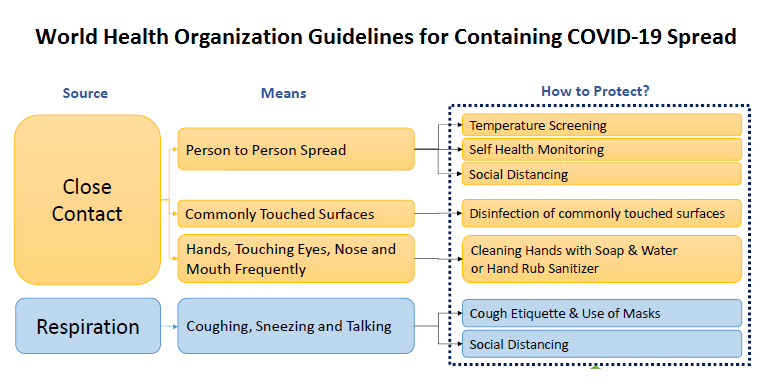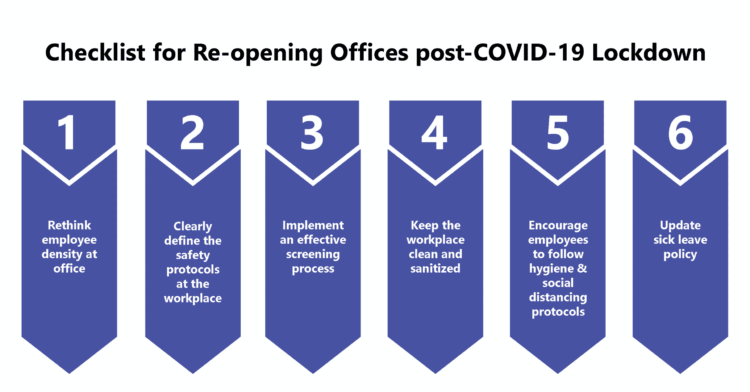1. Manage workplace density and safety protocols: Implement social distancing by rethinking office layouts, reducing employee density, encouraging remote work, and replacing physical meetings with virtual ones.
2. Define and enforce safety measures: Establish clear guidelines for hygiene and social distancing, including protocols for screening, mask-wearing, and sanitization of common areas and workstations.
3. Implement effective screening and cleaning procedures: Use daily screening processes like thermal checks and self-declarations to ensure regular cleaning and sanitization of the workplace, especially in high-touch areas.
4. Promote hygiene and update policies: Encourage employees to follow hygiene practices, update sick leave policies to accommodate COVID-19 situations, and maintain flexibility for remote work when necessary.
After the COVID-19 crisis, most organizations are looking to return to work from the office. This checklist for re-opening offices post-COVID-19 lockdown can help organizations keep health and safety measures at the forefront.

Organizations understand that returning to work from the office might not be as easy as flipping a light switch.
In fact, it might not return to the pre-COVID like normalcy for a long time. It would take the combined efforts of the HR, the management and the employees to gradually get the business operations running smoothly.
For most organizations, the HR, Admin, and Facilities teams will lead this effort and play a critical role in the necessary planning, logistics, and support.
The major concern for organizations would be balance business continuity with employee health and safety.


Organizations fully understand that though they are resuming operations, the threat of COVID-19 is still high.
So, they need to implement the World Health Organization (WHO)and government guidelines to ensure employee health and safety.
This is essential to ensure business continuity and minimization of the risk of COVID-19 spread at the workplace.
Hence, organizations need to come up with effective policies and standard operating processes to mitigate this risk:


As people return to work, social distancing will become the new norm. Hence, organizations need to rethink the permissible use of employee density at the workplace to avoid the risk of transmission.
They need to consider alternate seating arrangements and avoid physical meetings and gatherings of employees to ensure safe social distancing.
Organizations must also enable as many employees as possible to continue working from home to reduce workplace density.
Read more about the Benefits of Working from Home for organizations and employees.

Also, organizations must clearly define the safety protocols for social distancing and hygiene at the workplace.
Such measures should cover screening, wearing masks, travel, seating, meetings, common areas, and sanitization of the workplace.
Virtual meetings should replace in-person meetings as much as possible. It is also important to stagger the canteen timings and ensure social distancing and hygiene.
Social distancing needs to be followed even at the pantry, and disposable cups, etc., should be used.
In addition, organizations should work constantly and visibly to generate awareness about the importance of maintaining personal hygiene and safety.

Another critical step for organizations to make their workplaces safe for employees is an effective screening process.
These daily screening protocols can help minimize the chances of employees unknowingly bringing the COVID-19 virus into the workplace.
These measures should include thermal screening, voluntary self-declaration, wearing of masks, and using COVID-19 applications such as the Arogya Setu.
Security personnel may send employees back home for the day if they doubt their health.
They should screen visitors and vendors and ensure they wear masks compulsorily.

Another critical aspect that organizations should consider is ensuring the constant cleaning and sanitization of the workplace.
They should make sure that common areas, touchpoints, and workstations of employees are disinfected regularly.
The frequency of workplace cleaning should be increased.
The cleaning staff should wear personal protective equipment while performing the cleaning.

Encouraging employees to follow hygiene and safety guidelines is critical for organizations in the post-COVID scenario.
Employees should not come to the office if they are not feeling well and should immediately inform their supervisor/ HR.
Employee cooperation is required for voluntary declarations of health status, updating COVID apps, ensuring social distancing at the office or traveling in a cab or bus, wearing masks, avoiding crowding in the office pantry, canteen, or shared areas, etc.

COVID-19 has necessitated policy changes for organizations, including policies related to sick leaves.
The HR needs to update the sick leaves policy to cover the current COVID-19 situation.
It should cover the number of days of leave if employees test positive themselves or need to care for a positive-tested family member.
Organizations may also consider indefinite remote working for such employees to minimize work disruption and prevent disease spread.
Organizations looking at reopening their workplaces for employees shortly in this current COVID-19 situation need to carefully plan and implement the necessary processes to minimize the health and safety risks to employees while ensuring business continuity.

Lead author: Sagar Chaudhuri, the Co-Founder and CEO of HiFives. He is an HR Tech Evangelist with over 25 years of corporate and entrepreneurship experience. In the past, Sagar has worked in leadership roles at companies such as Genpact, Infosys, and ICICI Bank. He has an engineering degree from IIT Kharagpur and an MBA from IIM Lucknow. Connect on LinkedIn
To stay updated on the latest HiFives blogs, follow us on Twitter (@MyHiFives)